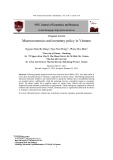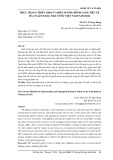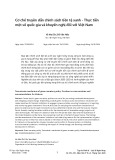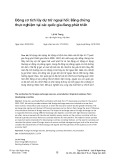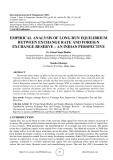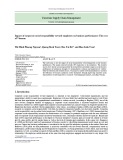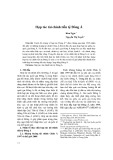DDEEPPOOCCEENN
Working Paper Series No. 2007/06
Nominal Rigidities And The Real Effects Of Monetary Policy In A Structural VAR Model Pham The Anh *
* School of Social Sciences, University of Manchester, UK Department of Economics, National Economics University, Vietnam
The DEPOCEN WORKING PAPER SERIES disseminates research findings and promotes scholar exchanges in all branches of economic studies, with a special emphasis on Vietnam. The views and interpretations expressed in the paper are those of the author(s) and do not necessarily represent the views and policies of the DEPOCEN or its Management Board. The DEPOCEN does not guarantee the accuracy of findings, interpretations, and data associated with the paper, and accepts no responsibility whatsoever for any consequences of their use. The author(s) remains the copyright owner. DEPOCEN WORKING PAPERS are available online at http://www.depocenwp.org
NOMINAL RIGIDITIES AND THE REAL EFFECTS
OF MONETARY POLICY IN A STRUCTURAL VAR MODEL§§§§
(cid:1)(cid:2)(cid:3)(cid:4)(cid:5)(cid:6)(cid:2)(cid:7)(cid:5)(cid:8)(cid:9)(cid:2)(cid:5)
School of Social Sciences, University of Manchester, UK
Department of Economics, National Economics University, Vietnam
June, 2007
Abstract
The paper proposes an empirical VAR for the UK open economy in order to measure the effects of monetary
policy shocks from 1981 to 2003. The identification of the VAR structure is based on short-run restrictions that
are consistent with the general implications of a New Keynesian model. The identification scheme used in the
paper is successful in identifying monetary policy shocks and solving the puzzles and anomalies regarding the
effects of monetary policy shocks. The estimated dynamic impulse responses and the forecast error variance
decompositions show a consistency with the New Keynesian approach and other available theories.
JEL codes: C30; E30; E32; E52.
Keywords: Structural VAR; Nominal Rigidities; Monetary Policy Shocks; New Keynesian Theory
§ This paper is a substantially revised chapter in my PhD dissertation at the University of Manchester, United Kingdom. I would like to thank Prof. Keith Blackburn and Prof. Denise Osborn for their useful comments. Correspondence: Tel.: +84 (4 ) 8693869, Email address: pham.theanh@yahoo.com.
1. Introduction
The vector auto-regression (VAR) methodology has become the most popular empirical
method in studying the effects of monetary policy after the publication of the seminal paper by
Sims (1980). During the past two decades there has been an extensive literature applying the
VAR approach to estimating the effects of monetary policy. However, there is still a lack of
consistency in the results. Different authors use different identifying assumptions, different
sample periods and different data sets and consequently, produce plausible but not consistent
results.1
In the framework of the VAR, the presence of puzzles in estimating the effects of monetary
policy makes it difficult for researchers to interpret. In particular, the VAR practitioners often
find a strong positive response of prices to a monetary policy restriction. This phenomenon is
well known as the price puzzle. Sims (1992) argues that if the central bankers have
information about inflation better than that can be estimated from VAR models they might
know that inflationary pressure is about to arrive and so contract the money supply to dampen
the effects of these pressures.
Furthermore, the phenomenon that the interest rate increases accompanying a rise in the
money supply, known as the liquidity puzzle, also often appears in VAR models. In
confronting the liquidity puzzle, Sims (1992) and Christiano and Eichenbaum (1995) argue
that innovations in broad money aggregates are more likely to reflect other structural shocks,
especially money demand shocks and they are not exogenous. They suggest the use of some
1 See Walsh (2003, ch.1) for a recent survey.
2
variable that are under the direct control of the central bank, such as the short-term interest
rate or the narrow monetary aggregate, as a measure of the monetary policy.
Recently, many papers such as Grilli and Roubini (1995), Kim and Roubini (2000), Astley and
Garratt (2000), Fisher and Huh (2002) have tried to use the VAR approach to model open
economies. In such models, along with the reaction of prices and interest rates to a monetary
policy shock, the behavior of the exchange rate is also studied as another important criterion
for assessing the plausibility of the VAR models. Unfortunately, many studies indicate that
there is an exchange rate puzzle – that is, the exchange rate persistently depreciates following
a monetary restriction rather than appreciates (see Grilli and Roubini, 1995 for example) as
would be predicted by theoretical models with sluggish price adjustment of Dornbusch (1976).
Sims (1992) and Grilli and Roubini (1992) argue that this anomaly of the exchange rate is
probably due to the fact that the monetary contraction is implemented during the period when
the depreciation is observed.
In addition to the impulse responses in the VAR framework, researchers also examine the
forecast error variance decompositions to assess the relative importance of the monetary
policy shocks in accounting for variance in both policy and non-policy variables of the system.
Most of the authors find that monetary shocks are not major sources of output fluctuations in
G-7 countries. More paradoxically, their models also suggest that money supply shocks play a
more important role in longer horizons (e.g., Turner, 1993).
3
In this paper we apply the structural VAR approach, which was first developed by Bernanke
(1986), Blanchard and Watson (1986) and Sims (1986), with the New Keynesian modeling
strategy to study the effect of monetary policy for the United Kingdom. It is shown that the
paper, with the given specification and data in question, does not suffer from the notorious
puzzles found elsewhere in the literature and can provide evidence supporting the New
Keynesian theory.
Up to now there are only a few empirical VAR models based on the New Keynesian
perspective that can provide evidence consistent with the predictions of models that assume
nominal rigidities and the real effects of money, especially for the United Kingdom. The
structural VAR models such as Turner (1993) and Jenkins and Tsoukis (2000) are developed
for the United Kingdom closed economy and show no significant role of money in accounting
for output fluctuations or evidence of price or wage inertia. The results are not supportive for
theoretical models with menu costs (Mankiw, 1985) or staggered price and wage contracts
(Calvo, 1983 and Taylor, 1979). Moreover, the two models ignore the role of the interest rate
as the main instrument of the Bank of England in establishing a monetary reaction function.
As a consequence, they can not distinguish money demand shocks from monetary policy
shocks. Monetary policy shocks are not exogenous and the price puzzle which is one of the
most crucial criteria to judging the validity of the VARs appears.
The structural VAR we construct in this paper is based on short run restrictions that are
consistent with the general implications of a New Keynesian model for the United Kingdom
open economy. Contemporaneous restrictions are imposed to separate monetary policy shocks
4
from money demand shocks. Our identification scheme is successful in identifying monetary
policy shocks and solving the puzzles and anomalies regarding the effects of monetary policy
shocks. The estimated dynamic impulse responses of the variables to a contractionary
monetary policy shock show a consistency with the New Keynesian approach and other
available theories. There is no liquidity, price, exchange rate, or forward premium puzzle. The
responses of prices and wages indicate nominal rigidity as suggested by Calvo/Taylor type
models with staggered contracts or by menu cost theory. The forecast error variance
decompositions show that monetary policy shocks account for an extremely low proportion of
fluctuations of nominal prices and wages. However, they contribute significantly, up to 40%,
to real output movements. This striking evidence is strongly supported by recent dynamic
general equilibrium models with sticky prices or sticky wages and makes our model different
from most previous structural VARs.
The remainder of this paper is organized as follows. Section 2 describes econometric
methodology. Section 3 describes data and pre-tests. Section 4 presents the structure of the
model. Section 5 examines the effects of monetary policy shocks in the United Kingdom
economy. Section 6 concludes.
2. Econometric Methodology
First of all, we briefly describe the econometric methodology used in this study. Following the
structural VAR approach developed by Bernanke (1986), Blanchard and Watson (1986) and
Sims (1986) we assume that the economy is described by a system of linear simultaneous
equations which model the dynamic interaction between the time series variables as follows.
5
(1)
Ay
C
)( yL
B
=
+
V
+
t
e t
t
where
ty is a vector of k time series variables; A and is the square matrix containing the
structural contemporaneous parameters of the variables; C is the vector of deterministic
;
variables;
is a matrix of polynomials, i.e.
)( L
L
2 L
r L
V
=
+
... ++
)(LV
V 1
V 2
te is the
rV
structural disturbance vector and by construction
(
0
,
for s = t and
E
I
) =tE e
' ( ee ) s t
k
=S= e
0
otherwise; and B is the square matrix reflecting the contemporaneous relationship
( tE ee
' =s )
between structural disturbances and the time series variables. The non-zero off-diagonal
elements of B allow some shocks to affect directly more than one endogenous variable in the
system.
The matrices A and B are constructed based on economic theories. Pre-multiplying (1) by
1-A
we have:
(2)
y
yL
u
+=
)(fd
+
t
t
t
where
and
(
0
,
f
1-= A
V
tu is the vector of reduced form VAR residuals which satisfies
) =tuE
otherwise.
symmetric, positive
0
(
)
for s = t and
k
S=)
k ·
( tuuE
' s
u
( tuuE
' =s )
uS is a
definite matrix and determined by the data. The relation between the structural disturbances
and the reduced form residuals are given by
(3)
u
e1-= BA
t
t
Consequently,
1 -
(4)
'
'
S =
1 - u A BB A
where the sample matrix of the reduced form residuals,
uS can be derived from the data as:
6
(5)
u
(cid:217) 1 T (cid:217) S = (cid:1) ' u u t t T
t
1 =
The main purpose of structural VAR estimation is to obtain non-recursive orthogonalization of
the error terms for impulse response analysis. This alternative to the recursive Cholesky
orthogonalization requires us to impose enough restrictions to identify the orthogonal
(structural) components of the error terms. Since the variance-covariance matrix
uS is a
symmetric, positive definite matrix and determined by the data we have
(
)
2/)1
k
k ·
( +kk
estimates. The structural coefficients in
square matrices A and B are unknown. The
(
)
k
k ·
diagonal elements of A are normalized to 1s. Therefore, as long as we impose theoretical
restrictions such that the total number of structural parameters to be identified in A and B is
less than or equal to
. This means that we impose at least
2/)1
2/)1
2/)1
2 2 k
( kk
3( kk
-
+
=
-
( +kk
restrictions, then all the structural parameters in A and B can be recovered from (4).
After the model is estimated the impulse response functions will be generated to trace the
effects of a structural monetary policy shock on all the variables in the VAR system. A long
with the impulse response functions we will also compute the forecast error variance
decompositions to examine the relative importance of each random innovation in affecting the
variables in the VAR. The computation of the impulse response functions and the forecast
error variance decompositions can be found in Lütkepohl and Krätzig (2004, chapter 4).
7
3. Data and Pre-tests
In this study, since monthly data for output and employment are not available we use quarterly
series for the sample period from 1981:2 to 2003:2. This sample is chosen based on the
availability of the data and to avoid the structural shift in monetary policy operation of the
Bank of England during 1979-1981 resulting from the establishment of the European
Monetary System in 1979 and the oil crisis in the 1979-1980. All the series are taken from
National Statistics (except for the interest rate which is taken from the Bank of England),
seasonally adjusted (except for the retail price index, the interest rate and the exchange rate),
and in logarithmic form (except for the interest rate). A complete set of dummy seasonal
dummies is included in the price equation in order to take into account the seasonality of the
variable2.
Following most papers in the VAR literature (Sims, 1980, 1992, Leeper et al., 1996, Kim,
1999, and Kim and Roubini, 2000, etc.), we do not investigate the possible cointegrations or
impose any long-run restrictions among variables. Given the relatively small size of our data
set, tests for integration and cointegration are likely to have low power. If we impose false
restrictions the economic inference would be incorrect at later stage. Furthermore, endogenous
growth models with nominal rigidities suggest that the long run neutrality of money restriction
may be invalid since any temporary disturbance can have a permanent effect on output as long
as it reallocates the amount of resources used for productivity improvements. Therefore, we
estimate the model in log-level form without imposing any long run restrictions.
2 The dummies in the price equation are jointly statistically significant at conventional levels. However, the estimation results are not sensitive to the exclusion of these variables.
8
The time series vector is ( ,
, ) '
,
,
,
,
n y p w m r e , where n is total employee jobs, y is real gross
domestic product, p is the retail price index, w is the wage index, m is the monetary aggregate,
r is the interest rate measured as the official bank rate, and e is the exchange rate index.
Employment, output, prices, the monetary aggregate and the interest rate are commonly used
in analyzing business cycles. Since the model aims to examine different sources of nominal
rigidities, the nominal wage variable is also included. The exchange rate variable is the
average rate (of a basket of currencies) against Sterling as used in Garratt et al (2003) and
Osborn and Sensier (2004). This variable is included in the model to allow for the Bank of
England to use information about the values of other currencies in setting the monetary rule in
order to stabilize the value of Sterling. Moreover, fluctuations in the exchange rate index
partly reflect changes in world prices. Therefore, the inclusion of the exchange rate index also
allows the Bank of England to respond to foreign price shocks and reduces the problem of
endogeneity of monetary shocks.
We use the retail price index instead of the more common CPI because, as noted in Osborn
and Sensier (2004), the UK inflation target relates to the retail price index3. Since M1 or M2
are not available for the UK we choose M0 rather than M4 as in other VAR models of the UK
by Jenkins and Tsoukis (2000) and Garratt et al (2003). Finally, we use the official bank rate
which is under direct control by the bank of England as the monetary policy variable. The
Bank seeks to meets their targets through the decisions on the official bank rate taken by the
Monetary Policy Committee. When the official bank rate is set, the commercial banks change
their own base rates from which deposit and lending rates are calculated. The interest rate set
3 CPI has only been used by the Bank of England since the beginning of 2004 which is out of the sample of this study.
9
by the Bank is quickly passed throughout the financial system, influencing interest rates for
the whole economy4.
We limit the maximum lag length of the model to six and implement the lag length test. Since
different criteria for minimising the forecast MSE indicate different lag length orders we do
rely on any single information criterion. Instead, we first perform different VAR orders and
then check the whiteness of the residuals with different types of tests in order to choose an
adequate VAR order. Both Portmanteau and LM-type tests for autocorrelation indicate that
that VAR(3) should be estimated.5 Finally, due to small sample problem the Chow test for
structural stability may not be reliable. Therefore, as in other VAR models of the UK (e.g.,
Jenkins and Tsoukis, 2000, and Garratt et al, 2003) we do not carried out structural break tests.
The sample period is chosen so as to avoid all possible structural breaks as mentioned above.
4. Structure of the Model
The model presented here is similar to that of Blanchard and Watson (1986) and Turner
(1993). The ordering of the quarterly time series vector is ( ,
, ) '
,
,
,
,
n y p w m r e . After the VAR
was estimated, we identified the A and B matrices that orthogonalized the variance-covariance
matrix of the residuals. Equation (3) can be described as follows.
4 See the Bank of England website for the detail of how the monetary policy works. 5 All the key estimation results still hold for VAR(4) model.
10
1
0
0
0 1
0 0
0 0
0 0
0 0
0 0
0 0
0 0
0 0
0 0
1
0
0
0
0
b 22 0
0
0
b 26 0
0
0
0
0
=
0 0
a 34 1 0
0 1
0 0
0 0
b 33 0 0
b 44 0
0 0
0 0
0
0
0
a 56 1
0
0
0
0
b 55 0
0
0
0
b 66 0
0
a 32 a 42 a 52 a 62 0
0
a 67 1
0
0
0
(cid:2) b 11 (cid:4) 0 (cid:4) (cid:4) (cid:4) b (cid:4) 41 (cid:4) 0 (cid:4) (cid:4) (cid:4) (cid:6)
(cid:2) (cid:4) a (cid:4) 21 (cid:4) 0 (cid:4) (cid:4) (cid:4) (cid:4) (cid:4) (cid:4) (cid:6)
b 77
a 53 a 63 a 73
a 75
a 76
(cid:2) (cid:3) (cid:3) e n (cid:4) (cid:5) (cid:5) e (cid:4) (cid:5) (cid:5) s (cid:4) (cid:5) (cid:5) e p (cid:4) (cid:5) (cid:5) e · (cid:4) (cid:5) (cid:5) w (cid:4) (cid:5) (cid:5) e md (cid:4) (cid:5) (cid:5) e (cid:4) (cid:5) (cid:5) mp (cid:4) (cid:5) (cid:5) (cid:4) (cid:5) e (cid:7) (cid:6) (cid:7) e
(cid:2) (cid:3) (cid:3) u n (cid:4) (cid:5) (cid:5) u (cid:4) (cid:5) (cid:5) s (cid:4) (cid:5) (cid:5) u p (cid:4) (cid:5) (cid:5) u · (cid:4) (cid:5) (cid:5) w (cid:4) (cid:5) (cid:5) u md (cid:4) (cid:5) (cid:5) u (cid:4) (cid:5) (cid:5) mp (cid:4) (cid:5) (cid:5) (cid:4) (cid:5) u (cid:7) (cid:6) (cid:7) e
where
,
,
,
,
, e e e e e e and
ee are the structural disturbances, that is, labor supply shocks,
w
md
mp
n
p
s
supply shocks, price shocks, wage shocks, money demand shocks, monetary policy shocks and
exchange rate shocks, respectively. The terms
,
,
,
,
,
u u u u u p
w
n
s
md
u and mp
eu are the residuals in
the reduced form VAR, which represent unexpected changes of each variable in the system.
The presence of the non-triangular shape of the A matrix (which allows for the separation of
the monetary policy and money demand equations and for the contemporaneous interaction
between the interest rate and the exchange rate), coupled with the non-zero off-diagonal
elements of the B matrix (which allows some structural shocks to affect directly more than one
endogenous variable in the system) differentiates this model from the recursive VAR
formulation.
Given this identification, and ignoring the lagged structural parameters, the contemporaneous
relationships between variables in the structural model can be written as:
n
(i)
b e11= n
(ii)
y
a n b
= -
+
21
e 26
be + 22 s
mp
(iii)
p
= -
-
+
33
a y a w b e 32 34 p
(iv)
w
bya
b
-=
+
+
42
44
e 41 n
e w
11
(v)
m
brapaya
-=
+
-
-
53
52
56
e55
md
(vi)
r
= -
+
-
a y a p a ex b e - 62
63
67
66 mp
(vii)
e
= -
-
+
76
75
a p a m a r b e - 73 77 e
Generally, with this identification we follow the New Keynesian economics in the sense that
due to menu costs or Calvo/Taylor staggered settings, nominal prices and wages respond to
unexpected changes in financial markets only with a lag. The monetary aggregate, the interest
rate and the exchange rate are all excluded from equations determining prices and wages.
More concrete discussion for each equation is presented below.
Initially, equation (i) implies that employment is determined solely by the labor supply
disturbances,
ne and not affected simultaneously by other variables. That is, within a period,
firms cannot adjust their employment in response to unexpected changes in product or
financial markets due to adjustment costs (e.g., firms have to pay compensations when they
lay off workers before the labor contracts expire). Real output is determined through equation
(ii) according to an Okun’s law relationship with employment. With employment included, the
supply disturbances in this equation can be interpreted as productivity shocks. Furthermore,
equation (ii) assumes that output is also determined by the monetary policy disturbances. An
argument for this identification is that a monetary policy restriction can affect investment and
this is more likely to create productivity innovations hence increasing output. This assumption
will be verified by examining the sign and the significance of the coefficient b26 in matrix B
discussed later.
12
Equation (iii) states that the price is determined according to a marginal productivity condition
along with its own disturbances pe as in Turner (1993). Prices are responsive to changes in
wages since firms set price as a mark-up of labor costs. Equation (iv) implies that the wage is
determined by output, employment disturbances and its own disturbance. The productivity
(TFP-like) disturbance,
se may affect the wage equation in some way however, instead of
introducing it directly in the equation we use output since most of the effect of the productivity
disturbance on the wage is transmitted through the effect it has on output. In addition, the
wage series includes bonuses thus this assumption is quite appropriate. All the variables in the
financial markets are excluded from equations determining prices and wages to reflect the
nominal inertia.
We employ a standard money demand function. The demand for real money balances depends
on real income and the nominal interest rate - the opportunity cost of holding money.
Therefore, in equation (v) all the other variables are contemporaneously excluded. Equation
(vi) plays the most important role in the model. It is known as the monetary feedback rule or
monetary reaction function. This equation is a modified Taylor’s rule and implies that, within
a quarter, the monetary authority sets the interest rate after observing the current values of
output, prices, and the exchange rate. However, employment is excluded due to information
delays. By including the exchange rate in the monetary reaction function the concern of the
Bank of England about the effects of a depreciation of Sterling on inflation can be taken into
account and the systematic responses to foreign shocks are believed to be excluded from the
monetary policy shocks. mpe is known as a monetary policy shock. It represents an unexpected
change in the short-term interest rate.
13
The last equation describes the exchange rate market. We assume that only prices, the interest
rate and the money supply can affect the nominal exchange rate simultaneously. This
assumption is based on purchasing power parity (PPP) condition and uncovered interest parity
(UIP) condition. All other variables are excluded from the equation reflecting the delayed
impact of variables such as output and employment on the exchange rate through import and
export activities.
In summary, the contemporaneous structure is composed of several blocks. Equations (i) and
(iv) describe labor market equilibrium. Meanwhile equation (ii) and (iii) reflect the
equilibrium in product market. Money demand and money supply functions illustrated by
equations (v) and (vi) describe monetary market equilibrium. Finally, the exchange rate market
is summarized by equation (vii). Next we will examine the plausibility of the identification by
looking at the sign and standard error of the estimated coefficients in matrices A and B as well
as implementing LR test for over-identification.
Estimation of A and B matrices
We choose a normalization so that the diagonal elements of the factorization matrix
are
1A B-
all positive. This normalization ensures that all structural impulses have positive signs (as does
the Cholesky factorization). Provided that A and B are non-singular they can be estimated by
maximum likelihood. Table 1 reports the estimates of all the elements in the matrices A and B.
Most of the coefficients in the matrices A and B have the correct signs and relatively low
standard errors. Importantly, all coefficients in the equation describing monetary policy have
14
the correct sign. Coefficient a62 and a63 are negative. This implies that the monetary authority
raises the interest rate when it observes unexpected increases in output and prices. That is, the
Bank of England takes a contractionary policy against a boom in the economy. Additionally,
the positive sign of a67 means that the monetary authority also increases the interest rate to
stabilize the value of domestic currency when there is unexpected exchange rate depreciation.
Coefficient a21 is negative reflecting the positive relationship between employment and output
as stated by Okun’s law. A negative a34 implies cost push inflation in equation (iii), while a
negative a42 implies that wages (included bonuses) are positively proportional to output. The
sign of a73 is questionable because, if home prices increase relative to foreign prices then
according to the PPP condition the exchange rate will fall and a73 in equation (vii) should be
positive. Otherwise, a73 will be negative. Moreover, under capital mobility, the UIP condition
requires that a fall in the domestic money supply or an innovation in the domestic interest rate
should be followed immediately by an appreciation of the home currency, otherwise there is a
exchange rate puzzle. Therefore, a75 and a76 should be positive and negative respectively.
Finally, Coefficients b26 and b41 which determine the contemporaneous impact of money
shocks on real gross domestic product and of employment shocks on wages respectively have
expected signs and relatively low standard errors. Importantly, all the diagonal elements of the
matrix B which are the standard deviations of the structural shocks are statistically significant
at 5%. This may indicate that the structural shocks are well identified in the model. Some
coefficients in the matrix A have moderate standard errors. However, these seem to be due to
the multicollinearity rather than due to low significance.
15
Since we impose six restrictions more than the minimum required, the Structural VAR is over-
identified at six degrees of freedom. Table 2 reports LR test for over-identification. The LR
test statistic is computed and given in the table.6 Under the null hypothesis that the restrictions
are valid, the LR statistic is asymptotically distributed
2 ( )qc where q is the number of over-
identifying restrictions. The result suggests that the structure can not be rejected at any
conventional significance level.
5. The Effects of Monetary Policy Shocks
5.1 The Expected Effects of a Contractionary Monetary Policy
Before reporting the empirical results we briefly discuss the expected movements of the
variables in response to a monetary contraction. Furthermore, we also summarize the expected
contribution of a monetary policy shock to fluctuations of output in the economy. If the
variables react as theoretically predicted the model can be considered plausible.
As mentioned above, VAR practitioners consider the absence of some puzzles, such as the
price and liquidity puzzles, as criteria for the validity of a model. If such puzzles appear there
is no way to say that the identified monetary policy shocks in our model precisely represent
true monetary shocks. A monetary contraction must be accompanied by a fall in the money
supply and a rise in the interest rate. The duration of the impact of the action on the interest
rate depends on the degree of nominal stickiness. The higher the nominal inertia, the more
persistent the effect becomes. If the menu cost theory proposed by the New Keynesian School
6 Test detail is provided in Lütkepohl and Krätzig (2004).
16
is valid, prices and/or wages do not decrease immediately. Consequently, employment and
output must decline at least in the short-run following the contraction.
Additionally, in a model with the exchange rate included, the absence of the anomaly of the
exchange rate behavior is also another important criterion for judging the validity of the
model. Given expected inflation, an increase in the interest rate is predicted to lead to an
appreciation of the domestic currency. Under rational expectations, the appreciation of the
exchange rate occurs as long as prices are sticky and there is an increase in the real interest
rate after the monetary contraction. For this point, the Dornbusch (1976) “overshooting”
model with sluggish price adjustment suggests that a negative monetary innovation will have a
positive impact on nominal interest rates and lead to an initial appreciation in the home
currency. However, according to the UIP condition, this appreciation will create the forward
premium puzzle; by borrowing aboard and then investing in domestic assets people can earn
extra profits. Therefore, if the UIP condition holds the value of the home currency must fall
after the initial appreciation following the monetary contraction. With a high degree of
sensitiveness of the financial markets this depreciation is expected to happen after one or two
quarters.
In computing forecast error variance decompositions, we can evaluate the importance of
monetary policy in the model. As claimed by Leeper et al. (1996) and Christiano et al. (1996),
for a good monetary policy, most variations in monetary policy instruments must be
attributable to systematic responses of policy to the development of the economy, not to
random disturbances to policy behavior. In addition, according to the New Keynesian
17
approach, monetary policy shocks, while not contributing much to price and wage movements,
should play an important role in output fluctuations at least in the short run. The effects on real
output should die out gradually in the medium run. Furthermore, for the theoretical validity of
the model the role of the productivity shocks can not be denied.
5.2 Impulse Response Functions
In this subsection we mainly examine the effects of a contractionary monetary shock on the
system through the estimated impulse response functions. In our model the monetary authority
sets the interest rate as a monetary policy instrument. This is consistent with the performance
of the Bank of England in practice. The monetary policy feedback rule can be expressed as
follows.
lag terms of all variables
(7)
=
+
+
+
+
0
f 3
r t
y f f f 1 2 t
p t
e t
First we discuss the consequences of a monetary policy shock in detail and consider how they
comply with the New Keynesian theory. Then we will decompose the variance of each
variable in the system to examine the relative importance of each variable to the fluctuations
of other variables.
The estimated impulse responses of the system to a one-standard-error monetary policy shock
are plotted in Figure 2. The upper and lower dashed lines in each graph are two-standard-error
bands computed by Hall’s percentile interval bootstrap method. These bands allow us to
determine whether the responses of the variables are significant or not at 95% confidence
level. As implied by the structure of the model, an innovation in the interest rate does not have
contemporaneous impact on nominal prices and wages but it does on money demand,
18
exchange rates and output. Figure 2 shows that, in response to a contractionary monetary
policy shock, the interest rate rises and the monetary aggregate falls significantly. This pattern
is consistent with liquidity effects. The impact response of the interest rate is always positive
following a contractionary monetary policy. However, it will gradually turn to the initial level
due to the deflation after the contraction.
More interesting, the monetary contraction starts to reduce prices and wages significantly only
after about two quarters. The response graph of nominal prices and nominal wages show that
they are sticky. Initially, they do not simultaneously decrease even though the rise in the
interest rate and the fall in the money supply are very significant. The response of nominal
prices shows a little bit more hysteresis. The pattern is consistent with New Keynesian theory
of menu cost and staggered contracts and suggests that prices and wages are quite persistent in
the United Kingdom economy. Both prices and wages tend to return to their long-run
equilibrium levels in two or three years after the monetary contraction. Generally, the effects
of the monetary contraction on prices and wages are very satisfactory in the context of the
New Keynesian theory. There is no evidence of price or wage puzzles. After the shock, the
price and wage levels do not respond much. They only start falling substantially in about two
or three quarter.
Consider next the effects of the monetary contraction on employment and output. Both
employment and output have the expected reactions. Employment decreases and reaches its
trough after about two years following the shock. It also shows a lag in response as compared
to output. This fact implies that, in facing a recession, firms adjust their production before they
19
can fire workers since labor contracts are always signed for long-term. The response of output
implies the non-neutrality of money, i.e. a change in money lead to a change in output. The
output level declines significantly right after the monetary contraction. It gets the lowest level
after about one year and tends to rise again when prices start to return gradually to the initial
level. The figure shows that the declines in the employment and output levels are very
persistent. They approach their long-run equilibrium levels about five years following the
contraction.
Finally, consider the effects of monetary shocks on the Sterling exchange rate. The response of
the exchange rate index also fits quite well with the theoretical behavior of the exchange rate
after a monetary contraction under the flexible exchange rate regime. Sterling appreciates
immediately following an innovation in the domestic interest rate. However, this appreciation
is short-lived reflecting a high degree of responsiveness of the financial market. After the
initial appreciation the exchange rate depreciates. This is not surprising because the UIP states
that under perfect capital mobility and rational expectations the following condition must be
satisfied:
d
f
(8)
(
)
=
-
-
r t
r t
e t
e t
1 +
d
f
where
te is the price of Sterling against foreign currencies, and
tr and
tr are domestic and
foreign interest rates respectively. Other things being equal, after an increase in the home
interest rate the home currency must depreciate otherwise there is a forward premium puzzle;
an investor can earn extra profits by borrowing abroad and then investing into the United
Kingdom financial assets. The behavior of the exchange rate in our model fits quite well with
existing theories about exchange rates. A persistent depreciation follows quite soon after the
20
impact change in the interest rate. The delayed overshooting lasts for only up to two quarters.
On this point, most of the previous VAR models such as Eichenbaum and Evans (1995), Grilli
and Roubini (1995) observed the persistence of appreciation for more than two years after the
initial monetary shocks. Kim and Roubini (2000) also find the delayed overshooting for about
two years for the United Kingdom economy and about one year for other G-7 countries. These
periods of delayed overshooting are too long and do not illustrate the sensitivity of the
financial market.
5.3 Forecast Error Variance Decompositions
Along with the impulse response functions we compute the forecast error variance
decompositions (FEVDs) to assess the relative importance of the structural shocks in
accounting for variance in both policy and non-policy variables of the system. This is a useful
way to determine whether monetary shocks have much contribution to fluctuations in output
or not. Table 3 reports the FEVDs for employment, output, prices, wages, monetary
aggregates, interest rates and exchange rates for various time horizons. At the top are the
structural shocks. Each value in the tables shows the fraction of the forecast error variance for
the corresponding variable that is attributed to the column variable shocks. The far-left column
presents the time horizons in quarters.
Table 3(a) shows that most of the employment fluctuations are attributable to its own shocks.
Output and monetary policy shocks have a little role, about 10% each after one year, in
forecast error variance of employment. However, their contributions rise remarkably in the
medium and long run. Table 3(b) reports the FEVD for output. As predicted by New
21
Keynesian theory, monetary policy shocks account for up to 40% of real output variance at a
quarter horizon. The importance of the monetary policy shocks gradually reduces to about
30% after one year. In the VAR literature, most of the authors find that monetary shocks are
not major sources of output fluctuations in G-7 countries. More paradoxically, their models
also suggest that monetary policy shocks play a more important role in longer horizons. In
particular, Turner (1993) and Jenkins and Tsoukis (2000) in their structural VAR models for
the United Kingdom conclude that the forecast error variance for real output is mostly
determined by its own shocks, and that monetary shocks contribute less than 15% output
variance at a horizon of three years.
In addition, price and wage shocks which can be interpreted as cost-push shocks contribute
almost nothing to output fluctuations at one quarter horizon. However, price shocks make up
about 10% of output fluctuations at one year horizon and this proportion increases further, to
about 25%, in the long run. Employment shocks also play a low role, about 5%, in output
variance at almost horizons. Meanwhile, the role of technological shocks, the crucial
determinant of output fluctuations in the Real Business Cycles literature, can not be denied.
They account for more than 40% of output variance at all most horizons. Finally, money
demand and exchange rate shocks contribute extremely little to output fluctuations. This
evidence implies that the United Kingdom economy is quite independent of foreign shocks.
Most of the forecast error variance of real gross domestic product is determined by
productivity and monetary shocks. This evidence, coupled with nominal rigidities given by the
impulse response functions, strongly supports the New Keynesian type models.
22
Tables 3(c) and 3(d) present the FEVDs for prices and wages respectively. As can be seen, at
any horizon, more than 50% of price and wage fluctuations are due to their own shocks. In
particular, price shocks account for approximately 80% of price fluctuations at one and two
quarter horizon and more than 50% thereafter. Employment shocks and wage shocks play a
moderate role in price fluctuations, with about 10% of the fluctuations comes from
employment shocks and about 5% comes from wage shocks at four quarter horizon. Monetary
policy shocks almost have no contribution to price variance within four quarters. Their role
rises up to only 10% afterwards. Money demand shocks and exchange rate shocks also play a
very modest role in price variance. Meanwhile, Table 3(d) also indicates that most of wage
fluctuations are attributable to its own shocks, with more than 50% after two years.
Employment shocks play a moderate role of up to 10% at almost horizons. In addition, output
shocks account for about 15% and 30% of wage fluctuations after one and two years
respectively. Monetary policy shocks as well as other shocks contribute very little to wage
fluctuations.
The FEVDs for monetary aggregates and interest rates are reported in Table 3(e) and Table
3(f) respectively. Table 3(e) shows that a very large proportion, more than 65%, of monetary
aggregate movements are from its own shocks at two quarter horizon. Interest rate and price
shocks, which are the important determinants of demand for money, play a remarkable role.
They collectively contribute up to about 40% to money demand variance after one year.
However, income contributes very little. This is not surprising because we use M0 as the
monetary aggregate and most of its movements are determined by the central bank behavior.
Interestingly, Table 3(f) shows that, almost all fluctuations in interest rates are attributable to
23
the shocks of other variables rather than its own shock. This suggests that the interest rate, the
monetary policy instrument in the model, is not decided by the random behavior of the central
bank but rather that it adapts to the unexpected changes of other economic variables. Equation
(7) can be considered as a good monetary policy reaction function of the central bank, as
claimed by Leeper et al. (1996) and Christiano et al. (1996).
Among the variables, the exchange rate plays the most important role in explaining the
movements in monetary policy. It accounts for 40% of the fluctuations in the interest rate at
one quarter horizon. This fact can explain why even the United Kingdom economy is a small
one but foreign shocks are not major sources of output fluctuations as shown in Table 3(b).
Prices play the second most important part in explaining interest rate fluctuations with more
than 30% at two quarter horizon. These results are very reasonable since, in practice, the
inflation rate and the exchange rate are the two most important objectives of the Bank of
England. They set the target for inflation at around 2% annually and also deal in the exchange
rate market every day to control the value of Sterling in terms of other currencies. In order to
control inflation and the value of the Sterling the monetary policy maker must set the interest
rate systematically reacting to the developments of prices and exchange rates. Employment,
output and wage shocks contribute moderately to interest rate movements, around 5%, at one
year horizon. However, the contribution of output shocks increases significantly in the long
run, up to 25% of interest rate fluctuations.
Finally, the FEVD for nominal exchange rates is presented in Table 3(g). Monetary policy
shocks are the most important source of nominal exchange rate fluctuations. They account for
24
around 40% and 30% of exchange rate movements at one and two quarter horizons
respectively. This evidence is strongly supported by Kim and Roubini (2000) and Fisher and
Huh (2002). In a structural VAR model for G-7 countries, Kim and Roubini (2000) find that
monetary policy shocks explain a very large proportion of nominal exchange rate movements
in the short run. They account for about 34% and 29% of nominal exchange rate fluctuations
in the United Kingdom at six and twelve month horizon respectively, a very similar result with
our model. Fisher and Huh (2002), in another structural VAR model for G-7 economies, also
find a very similar result for the United Kingdom.
Employment and output shocks also account for a high proportion, about 30% and 20%, of
nominal exchange rate movements after one year. This is because changes in income can lead
to changes in trade balances and hence the demand for foreign currencies. This effect is
significant only in the medium run. Additionally, price and wage shocks contribute almost
nothing to nominal exchange rate variance. This evidence may suggest that the PPP condition
does not hold.
5. Conclusions
In this paper we employed a structural VAR approach to study the effects of monetary policy
in the United Kingdom during the last twenty years. We identified the structural VAR model
based on the New Keynesian theory. The identification scheme is successful in identifying
monetary policy shocks and solving the puzzles and anomalies regarding the effects of
monetary policy shocks. The estimated dynamic impulse responses of the variables to a
contractionary monetary policy shock show a consistency with the New Keynesian approach
25
and other available theories. There is no liquidity or price/wage puzzle. The responses of
prices and wages indicate nominal rigidities as implied by Calvo/Taylor type models with
staggered contracts or by menu cost theory. At the aggregate level, prices and wages almost do
not respond within one or two quarters after a monetary innovation. This consequently allows
monetary policy shocks to have significant effects on real variables of the economy such as
output and employment. The impulse response functions also suggest that nominal prices are a
little stickier than nominal wages in the United Kingdom economy. Additionally, in the
context of an open economy, our model also contributes to solving the exchange rate puzzle
which quite often appeared in previous studies for the United Kingdom. As predicted by
theory, the nominal exchange rate appreciates right after the monetary contraction. However,
this appreciation lasts only for a few months. This provides evidence that the delayed
overshooting is not a problem and the UIP holds in our model.
Coupled with the impulse response functions, we generate the FEVDs which measure the
relative importance of each variable to the fluctuations of the others in the system. The results
show that monetary policy shocks account for an extremely low proportion of fluctuations in
prices and wages. However, they contribute significantly to real output movements, more than
30%, in the short run. The role of monetary shocks gradually decreases in the medium run as
prices and wages adjust. This striking evidence is strongly supported by recent dynamic
general equilibrium models with sticky prices or wages and makes our model different from
most previous structural VARs.
26
The FEVDs also indicate that production costs play an important role in price determination of
enterprises, with cost-push shocks accounting for more than 50% of fluctuations in prices.
Moreover, the significant contributions of exchange rate and price shocks to monetary
instrument fluctuations are consistent with the operation of the Bank of England in practice.
Last but not least, our model does not deny the contribution of productivity shocks which
make up about 30% of employment and 40% real output fluctuations in the long run
respectively. Overall, the results presented above are in line with the New Keynesian models
and show the validity of the identification scheme used in our structural VAR model.
27
APPENDIX: DATA DESCRIPTION
All data are obtained from National Statistics (except for the interest rate which is taken from
the Bank of England website). They are measured in quarterly frequency from 1981:Q2 to
2003:Q2 and include:
- Y:
- N:
- M0:
- R: - P:
- W:
- Ex:
Gross Domestic Product at constant 1995 prices, seasonally adjusted, code ABMI. United Kingdom Employee Jobs, total – thousands, seasonally adjusted, code BCAJ. Wide Monetary Base (end period), level #m, seasonally adjusted, code AVAE. The Official Bank Rate - not seasonally adjusted, code BEDR. All items Retail Prices Index (January 1987=100) - RPI, not seasonally adjusted, code CHAW. Whole economy wages (include bonuses) index, seasonally adjusted, Index 2000 = 100, code LNMQ (AEI). Average Rates against Sterling, Sterling Effective Exchange rate index 1990=100, not seasonally adjusted, code AJHX.
The model was estimated using JMulti software provided by Lütkepohl and Krätzig (2004).
28
REFERENCES:
Amisano, Gianni and Giannini, Carlo, (1997), “Topics in structural VAR econometrica”, Springer, 1997.
Astley, M. S. and Garratt, A. (2000). Exchange Rates and Prices: Sources of Sterling Real Exchange Rate Fluctuations 1973-94. Oxford Bulletin of Economics and Statistics 62 (4); 491-509. Bagliano. F. C. and Favero, C. A. (1998). Measuring Monetary Policy with VAR models: An Evaluation, European Economic Review 42; 1069-1112. Bernanke, Ben S. and Blinder, Alan S. (1992). The Federal Funds Rate and the Channels of Monetary Transmission. American Economic Review; 82 (4); 901-21. Bernanke, Ben S. (1986). Alternative Exploration of the Money-Income Correlation. Carnegie Rochester Conference Series in Public Policy 25; 49-100. Blanchard O. J. (1987). Why Does Money Affect Output? A Survey. Working Paper No. 2285, NBER. Blanchard, O. J. and Quah, D. (1989). The Dynamic Effects of Aggregate Demand and Supply Disturbances, American Economic Review 79; 139-83. Blanchard, O. J. and Watson, M. (1986). Are Business Cycles Alike, in Gordon, R. J. (Eds), The American Business Cycle: Continuity and Change. Chicago, University of Chicago Press. Calvo, G., (1983). Staggered Contracts in a Utility-Maximizing Framework, Journal of Monetary Economics 12; 383-98. Christiano, L. J., Eichenbaum, M. and Evans, C., (1996). The effects of Monetary Shocks: Evidence from the Flow of Funds, The Review of Economics and Statistics; 78 (1); 16-34. Christiano, L. J. and Eichenbaum, M. (1995). Liquidity Effects, Monetary Policy and the Business Cycle, Journal of Money. Credit and Banking 27 (4); 1113 - 36. Clarida, R., Gali, J., and Gertler, M. (2000). Monetary Policy Rules and Macroeconomic Stability: Evidence and Some Theory. Quarterly Journal of Economics 115; 147–80. Clements, M. P. and Mizon, G. E. (1991). Empirical Analysis of Macroeconomic Time Series: VAR and Structural Models. European Economic Review 35; 887-932. Eichenbaum, M. and Evans, Charles L., (1995). Some Empirical Evidence on the Effects of Shocks to Monetary Policy on Exchange Rates. Quarterly Journal of Economics 110 (4); 975- 1009. Faust, J. (1998). The Robustness of Identified VAR Conclusions about Money, Carnegie- Rochester Conference Series on Public Policy 49; 207-44. Fisher, L. A. and Huh H-S. (2002). Real Exchange Rates, Trade Balances and Nominal Shocks: Evidence for the G-7. Journal of International Money and Finance 21; 497-518. Fung, B. S. and Kasumovich M. (1998). Monetary Shocks in the G-6 Countries: Is There a Puzzle. Journal of Monetary Economics 42; 575-92. Garratt, A. Lee, K. Pesaran, M. H. and Shin, Y. (2003). A Long Run Structural Macroeconometric Model of the UK. The Economic Journal 113; 412-55.
29
Grilli, V. and Roubini, N. (1995). Liquidity and Exchange Rates: Puzzling Evidence from the G-7 Countries. New York University, Department of Economics Working Paper No. 95-17. Hamilton, J. D. (1994). Time Series Analysis. Princeton University Press. Jenkins, M. and Tsoukis, C. (2000). Nominal Inertia and Shock Persistence in UK Business Cycles. Applied Economics 32; 901-907. Kim, S. (1999). Do Monetary Policy Shocks Matter in the G-7 Countries? Using Common Identifying Assumptions about Monetary Policy across Countries. Journal of International Economics 48; 387-412. Kim, S. and Roubini, N. (2000). Exchange Rate Anomalies in the Industrial Countries: A Solution with a Structural VAR Approach. Journal of Monetary Economics 45; 561-586. King, R.G. and Watson, M. (1996). Money, Output, Prices, and Interest Rates. Review of Economics and Statistics 78; 35-53. Leeper, E. M. Sims, C. A. and Zha, T. (1996). What Does Monetary Policy Do? Brookings Papers on Economic Activity 2; 1-63. Lütkepohl, H. (1993). Introduction to Multiple Time Series Analysis. 2nd Ed, Springer-Verlag Berlin. Lütkepohl, H. and Krätzig, M. (2004). Applied Time Series Econometrics, Cambridge University Press. Mankiw, N. G. (1985). Small Menu Costs and Large Business Cycles: A Macroeconomic Model of Monopoly. Quarterly Journal of Economics 100; 529-37. Osborn D. R. and Sensier M. (2004). Modelling UK Inflation: Persistence, Seasonality and Monetary Policy, Centre for Growth and Business Cycle Research Discussion Paper Series 46, The School of Economic Studies, The Univeristy of Manchester. Sims, C. A. (1980). Macroeconomics and Reality. Econometrica 48; 1-48. Sims, C. A. (1986). Are Forecasting Models Usable for Policy Analysis?, Federal Reserve Bank of Minneapolis, Quarterly Review 10; 2-16. Sims, C. A. (1992). Interpreting the Macroeconomic Time Series Facts: The Effects of Monetary Policy. European Economic Review 36; 975-1011. Strongin, S. (1995). The Identification of Monetary Policy Disturbances: Explaining the Liquidity Puzzle. Journal of Monetary Economics 35; 463-498. Taylor, J. B. (1979). Staggered Wage Setting in a Macro Model. American Economic Review 69; 108-13. Turner, P. M. (1993). A Structural Vector Autoregression Model of the UK Business Cycle, Scottish Journal of Political Economy 40 (2); 143-64. Walsh, C. E., (2003). Monetary Theory and Policy. 2nd Ed., MIT Press.
30
LIST OF FIGURES
Figure 1: The Time Series (Log-Levels)
31
Figure 2: Impulse Responses to a One-Standard Error Monetary Policy Shock
t
l
n e m y o p m E
) a (
t u p t u O
) b (
s e c i r
P
) c (
s e g a W
) d (
32
(g) Exchange Rates
(f) Interest Rates
(e) Money
3 3
LIST OF TABLES
Table 1: Coefficient in Matrices A and B of the Structural Model
Expected Sign Coefficient Std. Error
Matrix A - -0.258 0.155 a21 - -0.010 0.082 a32 - -0.251 0.101 a34 - -0.198 0.086 a42 - -0.399 0.149 a52 - -0.448 0.367 a53 + 0.003 0.003 a56 - -131.470 149.575 a62 - -72.888 30.661 a63 + 28.905 19.690 a67 ? 5.228 3.759 a73 + 2.492 2.316 a75 - -0.047 0.039 a76
Matrix B - -0.003 0.001 b26 + 0.000 0.000 b41 + 0.003 0.000 b11 + 0.003 0.001 b22 + 0.003 0.000 b33 + 0.003 0.000 b44 + 0.006 0.000 b55 + 0.962 0.559 b66 + 0.035 0.018 b77
Table 2: LR Test for Over-Identification
Log likelihood LR Test Chi-square(6) Probability
34
2508.854 9.129 0.166
Table 3: Forecast Error Variance Decompositions
(a) Employment
(b) Output
(c) Prices
(d) Wages
N Y P W M R E Hz N Y P W M R E Hz 1.00 0.00 0.00 0.00 0.00 0.00 0.00 0.03 0.55 0.00 0.00 0.00 0.42 0.00 1 1 0.94 0.04 0.00 0.00 0.01 0.01 0.00 0.03 0.54 0.01 0.01 0.00 0.40 0.00 2 2 0.83 0.08 0.00 0.00 0.01 0.07 0.00 0.04 0.53 0.05 0.02 0.01 0.34 0.01 3 3 0.74 0.10 0.01 0.00 0.03 0.12 0.00 0.03 0.53 0.08 0.01 0.01 0.31 0.02 4 4 0.63 0.14 0.03 0.00 0.05 0.15 0.01 0.03 0.50 0.11 0.01 0.02 0.31 0.02 5 5 0.52 0.18 0.04 0.01 0.06 0.18 0.01 0.02 0.48 0.14 0.01 0.02 0.30 0.03 6 6 0.44 0.21 0.05 0.01 0.07 0.20 0.02 0.02 0.47 0.16 0.01 0.02 0.29 0.03 7 7 0.37 0.23 0.07 0.01 0.08 0.22 0.02 0.02 0.46 0.18 0.01 0.02 0.28 0.04 8 8 0.32 0.25 0.08 0.01 0.08 0.23 0.03 0.03 0.45 0.19 0.01 0.02 0.27 0.04 9 9 0.28 0.26 0.09 0.02 0.09 0.24 0.03 0.04 0.43 0.20 0.00 0.02 0.26 0.04 10 10 0.25 0.26 0.10 0.02 0.08 0.25 0.03 0.05 0.42 0.21 0.00 0.02 0.25 0.04 11 11 0.23 0.26 0.11 0.02 0.08 0.25 0.04 0.06 0.40 0.22 0.00 0.02 0.25 0.04 12 12
(e) Monetary Aggregate
(f) Interest Rates
N Y P W M R E Hz N Y P W M R E Hz 0.00 0.00 0.93 0.07 0.00 0.00 0.00 0.00 0.03 0.00 0.94 0.00 0.03 0.00 1 1 0.03 0.01 0.88 0.03 0.04 0.00 0.02 0.01 0.15 0.01 0.79 0.01 0.01 0.00 2 2 0.06 0.01 0.77 0.05 0.08 0.00 0.03 0.05 0.13 0.02 0.77 0.01 0.02 0.00 3 3 0.08 0.01 0.72 0.06 0.10 0.00 0.03 0.07 0.14 0.02 0.73 0.01 0.03 0.00 4 4 0.10 0.02 0.69 0.06 0.10 0.01 0.03 0.08 0.17 0.03 0.67 0.01 0.04 0.01 5 5 0.11 0.02 0.68 0.06 0.09 0.02 0.03 0.09 0.20 0.03 0.63 0.01 0.05 0.01 6 6 0.11 0.01 0.66 0.07 0.08 0.03 0.03 0.09 0.23 0.03 0.59 0.00 0.05 0.01 7 7 0.12 0.02 0.64 0.07 0.08 0.04 0.03 0.10 0.27 0.03 0.54 0.00 0.05 0.01 8 8 0.13 0.02 0.62 0.08 0.07 0.05 0.03 0.10 0.31 0.03 0.50 0.00 0.06 0.01 9 9 0.14 0.04 0.58 0.09 0.07 0.06 0.03 0.09 0.35 0.02 0.46 0.00 0.07 0.01 10 10 0.14 0.06 0.55 0.10 0.06 0.07 0.03 0.09 0.38 0.02 0.42 0.01 0.07 0.01 11 11 0.14 0.09 0.51 0.11 0.06 0.08 0.02 0.08 0.42 0.02 0.39 0.01 0.08 0.01 12 12
35
N Y P W M R E Hz N Y P W M R E Hz 0.00 0.01 0.01 0.00 0.84 0.09 0.04 0.01 0.12 0.26 0.02 0.07 0.10 0.42 1 1 0.02 0.03 0.03 0.01 0.64 0.22 0.05 0.02 0.06 0.31 0.04 0.09 0.10 0.38 2 2 0.02 0.03 0.06 0.05 0.48 0.25 0.12 0.04 0.05 0.31 0.07 0.11 0.12 0.31 3 3 0.02 0.02 0.09 0.07 0.37 0.30 0.13 0.05 0.04 0.33 0.07 0.11 0.11 0.28 4 4 0.01 0.02 0.12 0.08 0.28 0.34 0.15 0.07 0.04 0.34 0.07 0.10 0.10 0.27 5 5 0.01 0.02 0.15 0.08 0.23 0.35 0.16 0.08 0.05 0.34 0.07 0.10 0.10 0.26 6 6 0.01 0.02 0.17 0.08 0.18 0.36 0.17 0.08 0.09 0.32 0.07 0.10 0.10 0.25 7 7 0.01 0.02 0.19 0.09 0.15 0.37 0.18 0.09 0.12 0.30 0.07 0.10 0.09 0.23 8 8 0.01 0.02 0.20 0.09 0.13 0.37 0.18 0.08 0.16 0.28 0.06 0.10 0.09 0.22 9 9 0.01 0.02 0.21 0.10 0.11 0.38 0.18 0.08 0.19 0.26 0.06 0.11 0.10 0.20 10 10 0.01 0.01 0.22 0.10 0.10 0.38 0.18 0.07 0.22 0.25 0.06 0.11 0.10 0.19 11 11 0.01 0.01 0.22 0.10 0.09 0.38 0.19 0.07 0.24 0.25 0.05 0.12 0.10 0.17 12 12
(g) Exchange Rates
36
Hz N Y P W M R E 0.01 0.11 0.02 0.00 0.07 0.41 0.39 1 0.12 0.25 0.01 0.00 0.06 0.30 0.26 2 0.24 0.27 0.01 0.00 0.06 0.21 0.21 3 0.34 0.23 0.01 0.00 0.06 0.17 0.19 4 0.38 0.20 0.02 0.01 0.06 0.16 0.17 5 0.39 0.18 0.01 0.02 0.07 0.17 0.15 6 0.38 0.17 0.01 0.04 0.08 0.18 0.14 7 0.38 0.16 0.01 0.05 0.08 0.19 0.14 8 0.37 0.15 0.01 0.06 0.08 0.20 0.13 9 0.37 0.15 0.01 0.06 0.08 0.20 0.13 10 0.36 0.14 0.01 0.07 0.08 0.21 0.12 11 0.36 0.14 0.01 0.08 0.07 0.22 0.12 12



